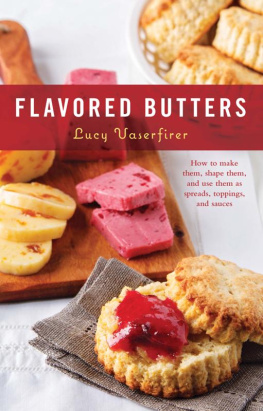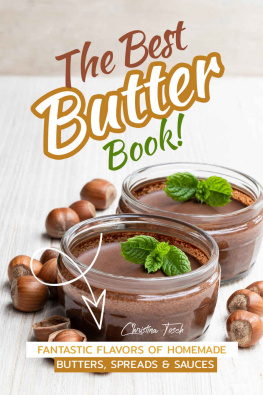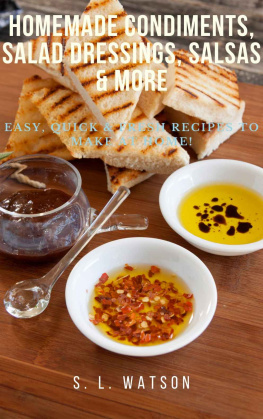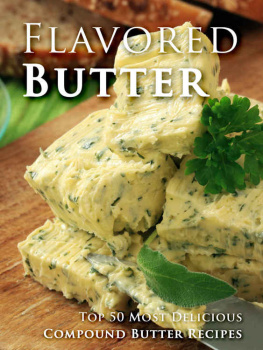The Harvard Common Press
www.harvardcommonpress.com
Text and photographs copyright 2013 by Lucy Vaserfirer
All rights reserved. No part of this publication may be reproduced or transmitted in any form or by any means, electronic or mechanical, including photocopying, recording, or any information storage or retrieval system, without permission in writing from the publisher.
The Library of Congress has cataloged the print edition as follows:
Vaserfirer, Lucy
Flavored butters : how to make them, shape them, and use them as
spreads, toppings, and sauces / Lucy Vaserfirer.
pages cm
includes index.
ISBN 978-1-55832-807-5
1. Cooking (Butter) 2. Butter. 3. Cookbooks. lcgft I. Title.
TX759.5.B87V37 2013
641.672dc23
2012035545
Special bulk-order discounts are available on this and other Harvard Common Press books. Companies and organizations may purchase books for premiums or resale, or may arrange a custom edition, by contacting the Marketing Director at the address above.
Photography, food styling, and prop styling by Lucy Vaserfirer
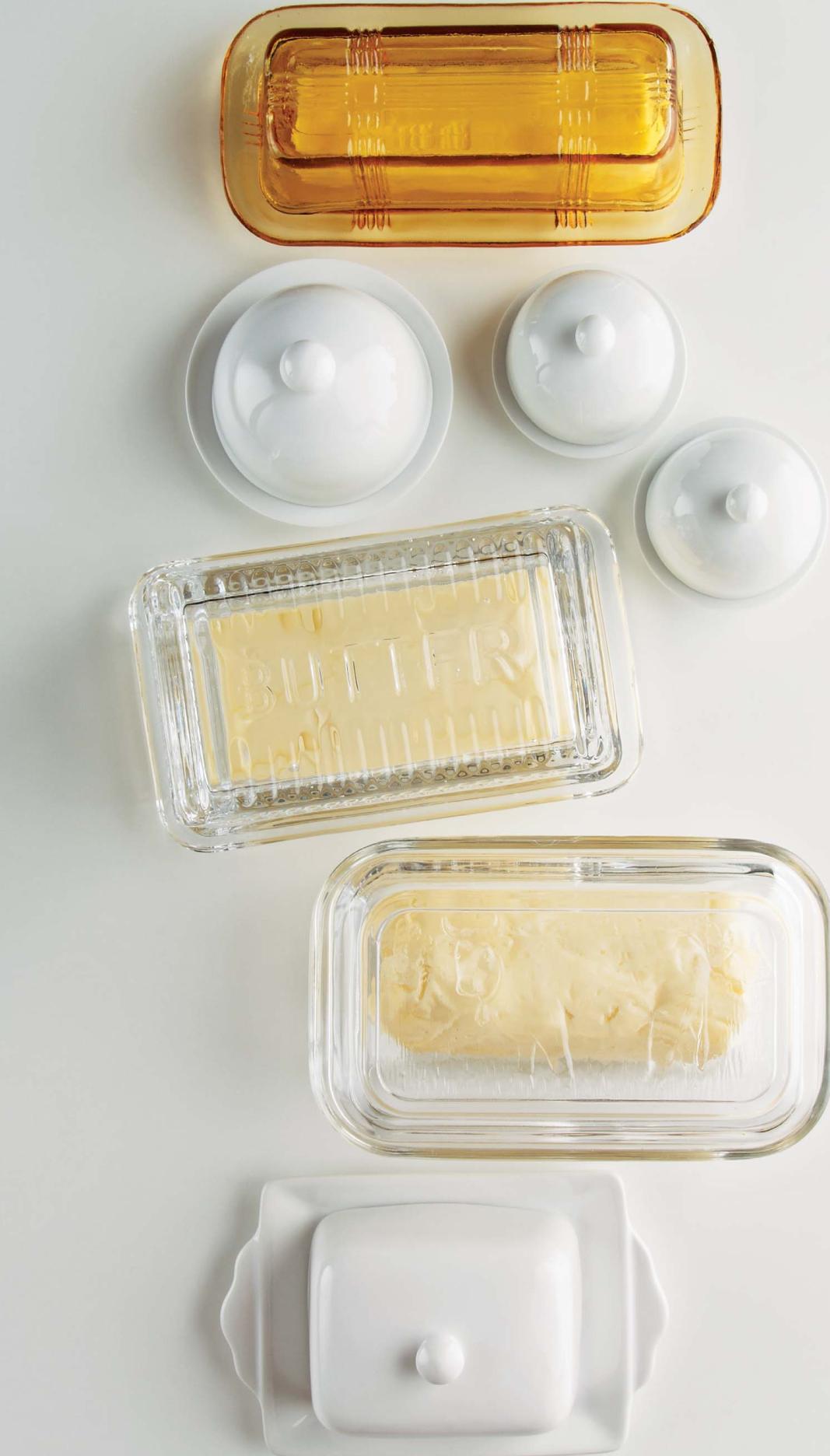
BUTTER BASICS
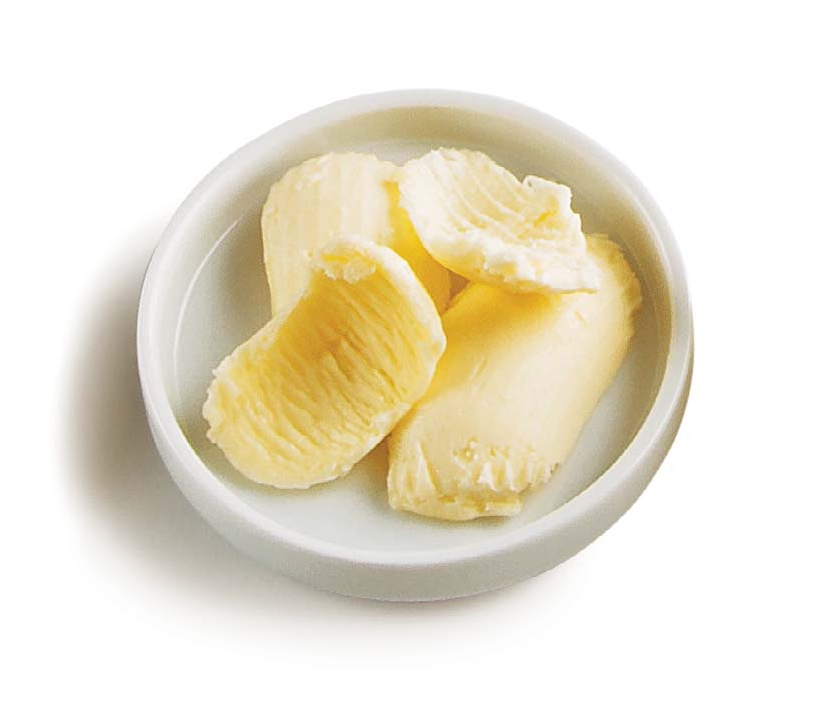
Flavored butters are culinary magic. With little more time or effort than it takes to wave a wand, memorable meals materialize! Witness these amazing transformations:
- An ordinary slab of meat turns into a gourmet grilled steak with Gorgonzola-Chive Butter () melting into it.
- A dull fish fillet becomes fit for fine dining topped with a pat of Dill, Lemon, and Garlic Butter ().
- Boring steamed vegetables suddenly appear irresistible glistening with Parmigiano Butter ().
This is no sleight of hand; its true alchemy. Learn how to make flavored butter, and youll be a wizard in the kitchen, conjuring up gourmet meals in minutes. Stash a couple of flavors in the fridge or freezer, and youll be able to pull amazing dinners out of a hateven on weeknights!
Flavored butters may have long been associated with fancy restaurants, but they really are so quick and easy to make. Stir together softened butter and your flavorings of choice, and there you have it. Serve a pat of your flavored butter on warm meat, fish, chicken, or vegetables; the heat transforms the butter into a rich, luscious sauce and the flavors bloom.
Flavored butter can be simple or sophisticated, savory or sweet. In its most basic form, flavored butter is nothing more than sweet cultured butter and sea salt, to be enjoyed slathered on bread. At its most luxurious, its butter blended with black truffles or caviar. And it can be anywhere in between, with ingredients such as garlic, shallots, fresh herbs, dry spices, cheese, olives, capers, anchovies, mustard, tomatoes, citrus zest, or honey. Flavored butters are delicious served over steaks, chops, and seafood, tossed with steamed seasonal vegetables, mixed into pasta or rice, or melting on pancakes or waffles. They can be used as a spread in sandwiches and panini, on breakfast toast and evening crostini, and they can be the start of countless canaps. The variations are endless. Flavored butters can embellish any meal from a leisurely brunch to a quick weeknight dinner to an over-the-top feast.
About Butter
Real butter is the basis of all flavored butters. The flavor and texture of real butter are incomparable.
Three componentsbutterfat, water, and milk solidsheld together in emulsion make up real unsalted butter. When butter is cold or at room temperature, the emulsion is stable, but the three components separate, or break, when butter is heated to the melting point.
Some flavor compounds are fat-soluble and some are water-soluble. Since butter contains both fat and water, its a great vehicle for other flavors.
Youll find that you have many options to consider when youre making a flavored butter.
Unsalted butter. This has the freshest, sweetest flavor and allows the cook control over how much salt is in the final product. This is my first choice for flavored butter recipes.
Salted butter. Salt is added as a preservative and can extend the shelf life of butter considerably. This means that salted butter may taste less fresh than unsalted butter. Its also impossible to know how much salt has been added. Salted butter can be used in flavored butter recipes, but be very careful about adding additional salt.
Cultured butter. This butter is made from fermented cream and has a mildly cheese-like flavor that is desirable in some flavored butters.
European-style butter. Because of its low water content, European-style butter is slightly richer and creamier than regular unsalted butter, and it makes fine flavored butter. Sometimes cultured butters are also labeled European-style.
Goat's milk butter. The distinctive flavor of this butter is desirable in some flavored butter recipes. Its also a good alternative for those avoiding cows milk.
SERVING SIZE
Convention says that a serving of butter is 1 tablespoon ( ounce). So a flavored butter made with 8 tablespoons of whole butter will serve 8unless youre generous when you portion it.
About Ingredients
Salt. Most of the recipes in this book call for coarse kosher salt, but fleur de sel or other coarse-grained finishing salts can be used when a little zing is desired. If you are substituting fine sea salt for coarse, use half the amount in the recipe. I find the flavor of iodized table salt harsh and offensive, and I never use it.
Pepper. Ground pepper loses potency quickly, so keep black peppercorns in a mill and grind as needed.
Some recipes call for cracked peppercorns, rather than ground, when a coarser texture is desired. A heavy mortar and pestle is the best tool for the job, but if you dont have this equipment, seal the peppercorns in a plastic bag and tap them with a rolling pin, meat mallet, or the bottom of a small, heavy pan.
Spices. Rather than buying preground cumin, coriander, mustard seed, fennel seed, cinnamon, cloves, allspice, cardamom, or star anise, buy these spices whole, then toast and grind them yourself to add a big flavor boost to your cooking. Dry heat brings out the essential oils in spices, heightening their aroma and flavor. Sesame seeds are also tastier toasted, though they are usually used whole.
The process is quick and easy. Heat a small, heavy saut pan (not a nonstick one) over medium heat until very hot. Add whole spices and toast, stirring constantly, for 1 to 2 minutes, or until very fragrant. The spices will be a shade or two darker when they are toasted. Watch them closely so that they dont burn. Transfer to a small bowl and let cool to room temperature. Grind the spices in a mortar and pestle, a spice mill, or a coffee grinder that you use exclusively for spices.
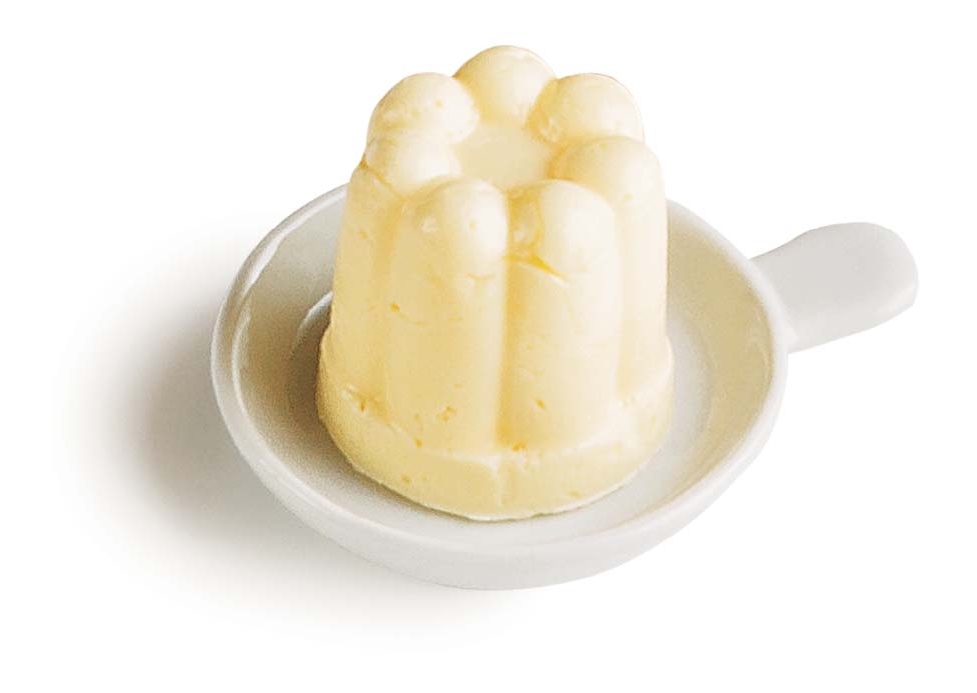
) and toast them on the stovetop.
Spread the nuts or seeds in a single layer on a rimmed baking sheet and bake in a 400F oven until golden brown and fragrant; theyll be a couple of shades darker when theyre ready. Baking time will vary depending on the size of the particular nut or seed and whether its whole, chopped, sliced, or slivered, so start checking after 5 minutes. Watch the nuts or seeds closely so that they dont burn, and remove them from the oven a few moments early to account for carry-over cooking time, since theyll continue to brown on the baking sheet even after theyre out of the oven. Let them cool before use. Hazelnuts (which will take 8 to 10 minutes to toast) have a papery skin that should be removed after they are toasted. Simply wrap them in a clean kitchen towel and rub; most of the skins will slip right off.
Next page
